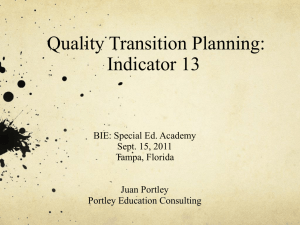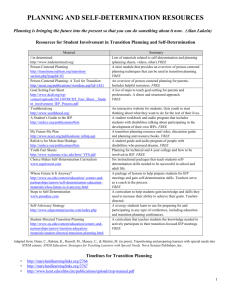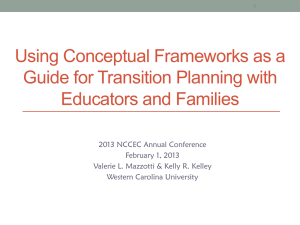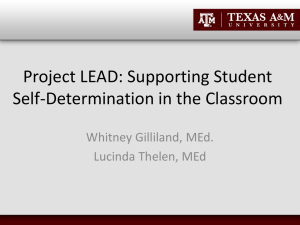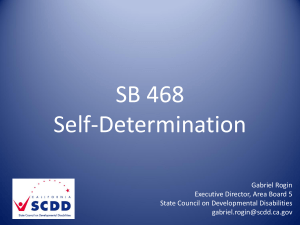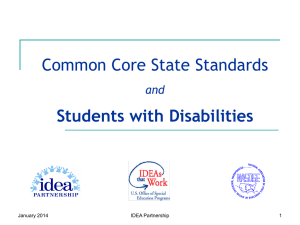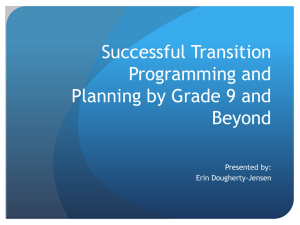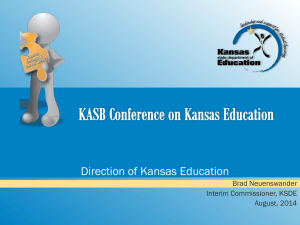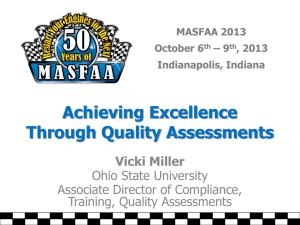Student Transition Assessment PowerPoint slides
advertisement
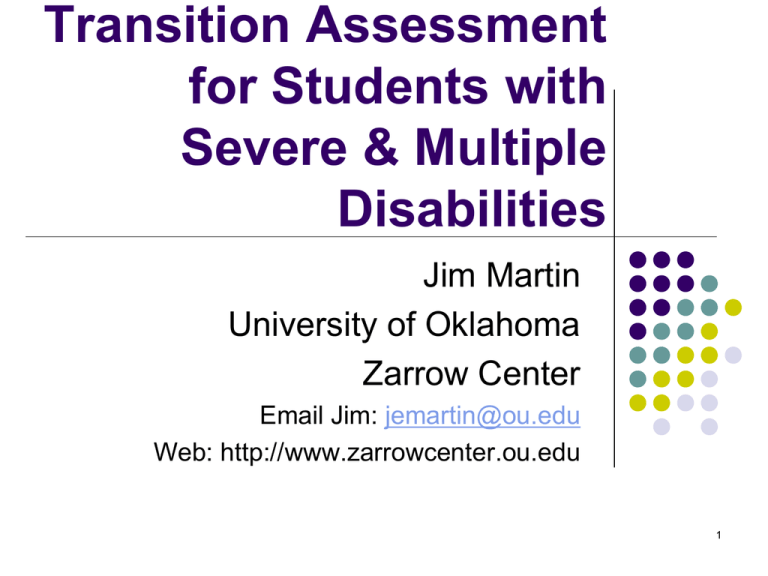
Transition Assessment for Students with Severe & Multiple Disabilities Jim Martin University of Oklahoma Zarrow Center Email Jim: jemartin@ou.edu Web: http://www.zarrowcenter.ou.edu 1 Agenda Introductions Part I Part II - Three-Part Transition Assessment Process Descriptions Independent Living Assessments & the IEP Career Interests/Skills & the IEP Self-Determination Assessments & the IEP Part III - Summary ASK QUESTIONS ALONG THE WAY! 2 Web Links Handout lists all the web sites used today See us to copy onto thumb drive so they can be clicked while open on your computer Easy to read compared to PowerPoint slides 3 Transition Assessment Timeline By ability and age or grade level, list recommended assessments. Enables all educators to know what assessments to use and when. Allow flexibility to meet student needs and development in the field. 4 Description of Students with Severe and Multiple Disabilities Demonstrate diverse skills, strengths, limits, and support needs Multiple system impairments that impact the student, family, community participation, and severity of associated health conditions Two or more simultaneously occurring impairments Supports are usually pervasive and extensive in order to achieve community living, employment, and self-sufficiency. 5 Description - continued Severity Continuum Severity Supports Communication issues - frequently Self-care issues – almost always Intellectual issues – often, but not always “Multiple” systems - always Mild Moderate Severe Profound 6 Abilities and Expectations NSTTAC 5-24-11 7 Recognizing Ability 8 Lauren’s Satisfying Life… 9 Postsecondary Goals Each student of transition age on an IEP, must have a postsecondary goal. This postsecondary goal must address: Education/training, employment Independent living. Need at least 1 annual goal and associated objectives for each postsecondary goal. 10 Sample Postsecondary Goals Education/Training: Jessie will audit child care/early childhood classes at the local Career Tech Center with a full-time HTS. Employment: With the help of a full-time HTS, Jessie will work at a community not-for-profit childcare program. Independent/Adult Living: Jessie will live in a group home and utilize public transportation to participate in her classes and work at her job site. 11 Annual Transition Goal Matches postsecondary goal Measureable and be accomplished in a year 12 Quiz Time!!!! 1. 2. 3. 4. After high school, Calvin will live and participate as he can at home, volunteer at his church weekly, and work with job coach at a community job. Using customized computer applications (auditory reader and voice activation) Calvin will respond to children and staff with 90% accuracy for 12 consecutive interactions. After graduation, Kelly will take journalism classes at the Career Tech and work for a publisher. Kelly will describe 5 accommodations she needs in the general education setting and why she needs them with 100% accuracy. 13 Three-Part Transition Assessment Model 14 The Purpose of SPED . . . a free appropriate public education that emphasizes special education and related services designed to meet students’ unique needs and to prepare them for further education, employment, and independent living. 2004 IDEA Changed Secondary SPED 15 IDEA 2004 Post-Secondary Goals IEPs must include appropriate measurable postsecondary goals based upon ageappropriate transition assessments related to training, education, employment, and when appropriate, independent living 16 Student Transition Questions Postschool Goal Questions Where do I want to live Where do I want to work? Where do I want to learn? Annual Transition Goal Question What do I need to learn now to live where I want? What do I need to learn now to do the career I want? What do I need to learn now to be able to learn where I want? Greene, G., & Kochhar-Bryant, C. A. (2003). Pathways to successful transition for youth with disabilities. New Jersey: Merrill Prentice Hall. 17 Transition Assessment Model Components 1. 2. 3. Independent Living Assessment Vocational Interest and Skills Assessment Self-Determination Assessment Most are informal and lack valid & reliable studies. They ARE good for instructional planning!! 18 Independent Living Assessments Part 1 of the 3-Part Transition Assessment Model This is the area that oftentimes impacts so many other postsecondary pursuits for students with severe and multiple disabilities. 19 Our Belief The law states that an independent living goal be addressed “when appropriate.” We believe that to determine if an independent living goal needs to be written, an adaptive behavior assessment needs to be given. This provides evidence of needing an independent living goal or not. How else would a team determine if an independent living goal is needed? Need to be functionally easy to use! Need to be free or reasonably priced. 20 Independent Living Assessments – We‘ll Focus on a Few Personal Preference Indicators (PPI) Supports Intensity Scale Great tool for students with significant support needs Life Skills Inventory Used by many adult service programs Enderle-Severson Transition Assessments Adult Living and Employment Versions Informal and free Casey Life Skills On-line and free 21 Personal Preference Indicators Designed for students with significant support needs Adult Living and Employment Supplement Interview format Family members, friends, professionals who know student well Likes, dislikes, social indicators, choices Health, body clock, future http://education.ou.edu/zarrow/ Cost: free Use the results in PLEP 22 PPI Example Page 23 Supports Intensity Scale American Association on Intellectual and Developmental Disabilities (AAIDD) 24 Supports Intensity Scale American Association on Intellectual and Developmental Disabilities 444 North Capitol Street, NW • Suite 846 Washington, DC 20001 Ph: 202.387.1968 • Fax: 202.387.2193 • www.aaidd.org TO ORDER Call: 301-604-1340 to place order or request a Publications Order form Price: Set: $125.00 Manual: $95.00 25 Interview forms: $38.75 100 Interview forms: $147.25 http://www.siswebsite.org/ 25 Supports Intensity Scale Four-Component Planning Process 26 27 Enderle-Severson Transition Rating Form ESTR-J ESTR-III Students with mild disabilities Parent (available in Spanish) and Teacher version Five Transition areas Students with “more” disabilities Parent and Teacher version Five Transition areas ESTR-S Students with severe/multiple impairments Parent and Teacher (on-line only) versions Employment, Rec/leisure, home living, community participation, and adult life Estr.net (each costs $2.00) 28 ESTR III Example 29 ESTR-S Example 30 Life Skills Inventory 15 domains (money, hygiene, safety, etc) Four levels: basic, intermediate, advanced, exceptional Includes Job skills too! Must know 3 of 5 to advance from basic to intermediate Must know the person Cost: free Google Life Skills Inventory or Download fromhttp://www.dshs.wa.gov/pdf/ms/forms/10_26 7.pdf 31 32 33 Casey Life Skills Web based Spanish, French or English, with numerous supplemental assessments Youth and caregiver formats Automatically scored and sent to you Provides different levels of questions for students across functioning levels Level 1 basic skills Level 4 complex skills Caution: It over-estimates skills for students with the most disabilities Cost: free Available at: www.caseylifeskills.org 34 35 Cautions Interpretation!! Casey Life Skills may give inaccurate results for students with SMDD by overrepresenting skills! 36 Tolby’s Assessment Results 37 Functional Situational Assessment for Independent Living Skills TASK ANALYSIS A Task Analysis consists of a written list of the discrete steps required to complete a task, such as doing laundry, brushing teeth, mopping a floor, setting a table, maintaining a work setting, etc. 38 Level of Assist TA NSTTAC 5-24-11 39 Sample Task Analysis - NSTTAC NSTTAC 5-24-11 40 Summary of Independent Living Assessments… 41 Vocational Interest and Skill Assessments Part 2 of the 3-Part Transition Assessment Process 42 Functional Vocational Assessment Over time Repeated Measures Situational Assessment 43 Belief Work benefits individuals emotionally and socially Enables individuals to contribute to society and to their own well being Can be done without fear of losing social security or other benefits Adds meaning to life 44 Employment Options Individual Competitive Employment Individual Supported Employment Group Supported Employment At Home or Community-Based Entrepreneurial Jobs 45 Career Development Stages Awareness Exploration Preparation Assimilation Advancement Job Change(s) Exiting to Retirement 46 Choice Making Logical choice making occurs when chosen preferences match available jobs. Discrepancy problems occur when Chosen job, task, and characteristics do not match specific jobs Discrepancy problems diminish when job site characteristics match preferences Task is to provide ample opportunities for students to determine matches and nonmatches. 47 Tolby’s Sample Postsecondary Goal Tolby will live at home with his mother, and with the support of a job coach and on the job training he will play music during dance and nap times at a local not-forprofit children’s day care center. 48 Vocational Assessments – we’ll focus on a few Personal Preference Indicators (PPI) Community Situational Assessment Process Adult Living and Employment Versions Video: Choose and Take Action Vocational Assessment Software Written: Choosing Employment Goals Illustrated: Self-Directed Supported Employment Illustrated Interest Inventory Video Career Exploration Employability Skills Assessment 49 Personal Preference Indicators Adult Living and Employment Supplement Interview format Family members, friends, professionals who know student well Likes, dislikes, social indicators, choices Health, body clock, future http://education.ou.edu/zarrow/ Cost: free Use the results in PLEP 50 Choose and Take Action Vocational Assessment Software Use of a software program and community experiences to identify entry-level job interests 51 Target Population Secondary students and adults with moderate to significant cognitive needs who: Have difficulty getting information from print Can attend to a computer screen Can follow simple 1 or 2 step directions Have limited to no previous work experience 52 CTA Constructs • Vocational Choice Making Characteristics Setting Activities (jobs) • Planning • Community Experience Watch Do • Self-Evaluation • Choose Again with Adjustment 53 CTA Choice Factors 14 entry-level vocational settings found in most communities 15 job activities repeated across two settings Care for animals in a vet’s office Care for animals in a retail store 12 characteristics repeated across two or three activities Working in a factory where it is inside and noisy 54 CTA Features A navigator to give instructions and guide user through the program Restricted mouse movements Highlight critical features as navigator says them Record made of all choices Input options may include user installed touch screen 55 Format designed so teachers can add comments on student performance Teacher can set number of video clips student can see in one trial Pair of video clips presented together Minimum teacher control over available video choices 56 Settings Activities Characteristics Car repair shop Bag items/bring carts Big open space Child care center Care for animals Small space Construction site Care for people Clean Factory Care for plants Messy Greenhouse Clean-up Few people Grocery store Clear tables Many people Hospital Filing Inside Hotel Handle materials Outside Janitorial service Heavy cleaning Noisy Landscape Company Laundry Quiet Office Move things Wear own clothes Restaurant Do paperwork Wear a uniform Store Stock shelves Vet Office Wash dishes Yard work 57 58 59 60 61 Publisher Choose and Take Action: Finding a Job for You Sopris West 4093 Specialty Place Longmont, CO 80504 800.547.6747 www.sopriswest.com 62 Community-Based Situational Assessment Process Repeated data collection across time Written assessments Illustrated assessment NSTTAC 5-24-11 63 Job Characteristics I Like Teach Job Characteristics Important selection factor Introduces Match Concept between What I like What’s at their job Computes % of Matches 64 Key: Determine Match Between What I Like and What’s At Their Site 65 Each time student chooses a characteristic one more cell on the graph is marked 66 Characteristics I Like vs Here Compares initial preferences to those experienced at a particular job site. 67 Build Forms Few vocational illustrations exists Cut and paste the SDSE illustrations to make forms Go to: http://brookespublishing.com/picturebank/ Use these with Pages or In-Design page layout program to build own forms electronically 68 Job Duties I Like Identifies job duties Based upon current job or work experience Assess preferences for job duties Calculate % of Job Duties I Like 69 What Do I Like? 70 71 Job Duties - How I Did Job duties identified and written onto form Student evaluates speed, independent performance, and accuracy Supervisor evaluates speed, independent performance, and accuracy Match made between student and supervisor 72 Uses self-evaluation methodology to teach job performance skills and to assess job duty skills 73 Work, Social, & Personal Skills Student rates performance Supervisor or teacher rate performance Calculates what supervisor thinks Calculates match between worker and supervisor 74 Personal Improvement Contract 75 Self-Determination Contracts to solve on-the job problems 76 My Employment Plan 77 Written Forms Taken From: Choosing Employment Goals Sopris West Publishers (www.sopriswest.com) Requires reading and writing skills 78 Illustrations Taken From Self-Directed Employment Download free illustrations Paul Brookes Publishing Baltimore www.brookespublishing.com www.brookespublishing.com/picturebank Can use words or illustrations Can do the same with digital pictures from your own camera 79 Illustrated Interest Inventories Trouble reading, but can understand concept. High level jobs NSTTAC 5-24-11 80 COPS-PIC Non-Verbal Assessment of Occupational Interest EDITS / P.O. Box 7234 / San Diego, CA 92167 800-416-1666 / 619-222-1666 / Fax 619-2261666 25 copies for $50.90 81 Career Awareness & Exploration via Video Video by Job Clusters Video http://acinet.org/acinet/videos.asp?id=27,&nodeid=27 Provides numerous videos for students to watch English or Spanish Job cluster and skill categories 82 83 Employability Skills Assessment 8 Domains Self-Help Skills Work Habits Task Related Work Quality Relations with Supervisor Relations with Peer Work Attitudes Profile by age Cost Free – Google “Employability Skills Assessment” 84 85 86 Summary of Vocational Assessments… 87 Self-Determination & Self-Advocacy Assessments Part 3 of the 3-Part Transition Assessment Model 88 Self-Determination Constructs • Self-awareness • Self-advocacy • Self-efficacy • Decision-making • Use of self-management strategies to attain plan • Self-evaluation • Adjustment 89 Why SD Assessment? Improved postsecondary outcomes Goal setting during early adolescence Awareness of disability Goal attainment Improved academic performance Limited studies so far 90 Self –Determination Assessments – We’ll focus on a few Guide to Assessing College Readiness AIR Self-Determination Assessment Student, Parent, Teacher Versions ARC Self-Determination Assessment Student Version 91 Guide to Assessing College Readiness Landmark College “Parent” Assessment Read each item with student and discuss Provides Assessment for Self-Advocacy to include in annual transition goals Five Domains Academic Skills Self-Understanding Self-Advocacy Executive Functioning Motivation and Confidence 92 AIR Self-Determination Assessment Parent Version Teacher Version Student Version Available at http://education.ou.edu/zarrow Cost: free 93 94 Example Present Level of Achievement Using the AIR Self Determination Assessment Strengths Current Assessment Data Bill obtained a 48% on the AIR Educator SelfDetermination Assessment. Objective Statement Bill has about half of the overall SD skills and opportunities needed to master these skills. He needs increased school and home opportunities to develop and master additional SD skills for success in welding school. Anticipated Effects Knows own ability and limitation and can express these Set goals Change plan to accomplish goals When provided the opportunity to set and express goals at his next IEP meeting, Bill can engage in this activity. Needs Opportunities at school and home to learn and practice additional SD 95 skills Annual Transition Goal: Education/Training Goal Bill will increase his overall self-determination score from 48% to 75% as measured on the AIR self-determination assessment. Objective/Benchmark To demonstrate leadership at IEP meetings, Bill will increase his scores on the Expressing Goals section of the ChoiceMaker Self-Determination Assessment from 20% to 90%. Bill will develop and implement a weekly goal attainment plan to attain two or more IEP goals by successfully completing 90% or more of the Take 96 Action Goal Attainment process. Annual Education/Training Coordinated Activities Coordinated Activities Bill will share his weekly goal attainment plan with his family. Responsible Parties Bill and special education teacher Bill and parents Bill will build his SOP with his family to share at the IEP meeting. 97 ARC Self-Determination Assessment Student version Must use the manual to score Cost: free Available at http://education.ou.edu/zarrow 98 Summary of Self-determination Assessments 99 Program Summary Creative Thinking Produces Meaningful Job, School, & Independent Living Outcomes! 100 101
